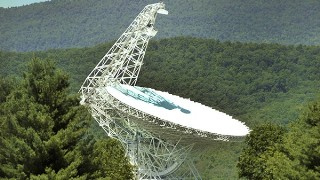Jul 23 2015
A West Virginia University expert says humanity’s first attempt to detect signs of alien life started 55 years ago in the University’s backyard and is one of the only places in the world that an unprecedented reinvigoration of the search can continue.
 Green Bank Telescope. WVU Photo by M.G. Ellis
Green Bank Telescope. WVU Photo by M.G. Ellis
Earl Scime, chair of the Department of Physics and Astronomy, said radio astronomer Frank Drake pioneered the search for extraterrestrial intelligence when he began Project Ozma at the Green Bank Telescope in the early 1960s. Yesterday (June 20), entrepreneur Yuri Milner and cosmologist Stephen Hawking announced Breakthrough Listen, the biggest scientific search for signs of intelligent life in the universe.
The 10-year, $100 million international initiative will use the world’s two most powerful telescopes – the Robert C. Byrd Green Bank Telescope in Pocahontas County and the Parkes Telescope in Australia.
Using the high-powered instruments, scientists will gather data from the 1 million stars closest to Earth. Beyond the Milky Way, scientists will listen for signals from the closest 100 galaxies.
“The enormous size of the Green Bank Telescope and the advanced technology that it offers make it the most sensitive radio telescope in the world,” Scime said. “There are very few places in the world where you can conduct this type of research, and West Virginia is one of them.”
Scime said that the 100-meter dish glides around a 360-degree track, making it able to view nearly 85 percent of the celestial sphere. Its sophisticated detectors allow it to record even the faintest signals from space.
With large amounts of dedicated time at the Green Bank Telescope, the program is 50 times more sensitive and will cover 10 times more of the sky than any previous programs dedicated to searching for extraterrestrial intelligence.
The program will also scan at least five times more of the radio spectrum and will do it 100 times faster.
For example, if a civilization located around one of the 1,000 nearest stars transmitted to Earth with the power of common aircraft radar, the Green Bank Telescope could detect it.
“WVU has had a close relationship with the Green Bank Telescope for more than 10 years,” Scime said. “Our researchers conduct experiments, our faculty teach undergraduate and graduate students, and we collaborate on educational opportunities for children at the site.”
In 2013, WVU agreed to partner with the telescope to fund operations in exchange for dedicated operating time on the instrument. WVU faculty and the National Radio Astronomy Observatory, which manages the site, also created the Pulsar Search Collaboratory to help encourage the next generation of scientists.
WVU researchers also received a federal grant to build a new detector for the telescope to increase its field of view, allowing it to map the sky three to five times faster.